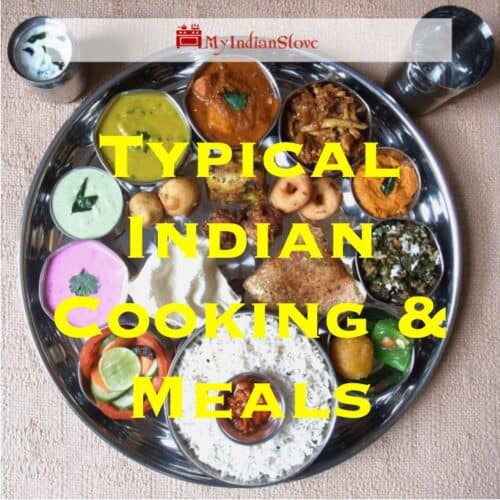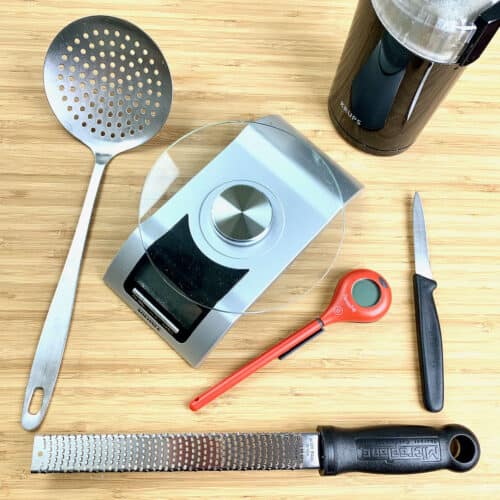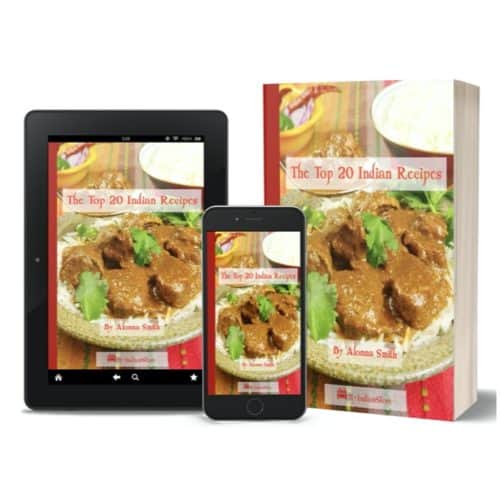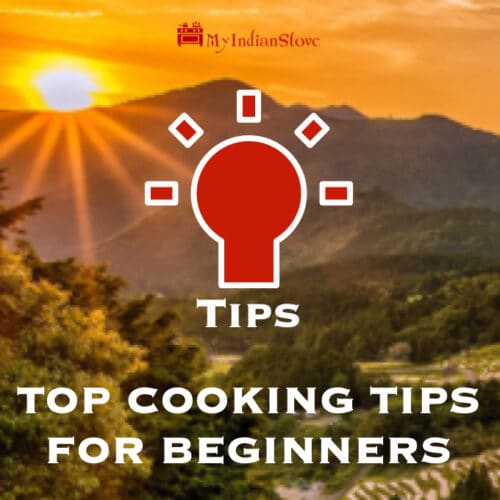One of the secrets of good Indian cooking is a well-stocked pantry. Depending on the dishes you tend to cook, your beginner's pantry list of essentials may look different from mine. But you probably have whole black peppercorns, ground cinnamon, cumin, turmeric, cloves, paprika (sweet not smoked), and whole nutmeg in your pantry already!
Unsure of a term, see the Indian Food Glossary. And for more beginners' help my Top 10 Tips for Indian Cooking Basics and the 6 Must-Have Indian Kitchen Utensils Online.
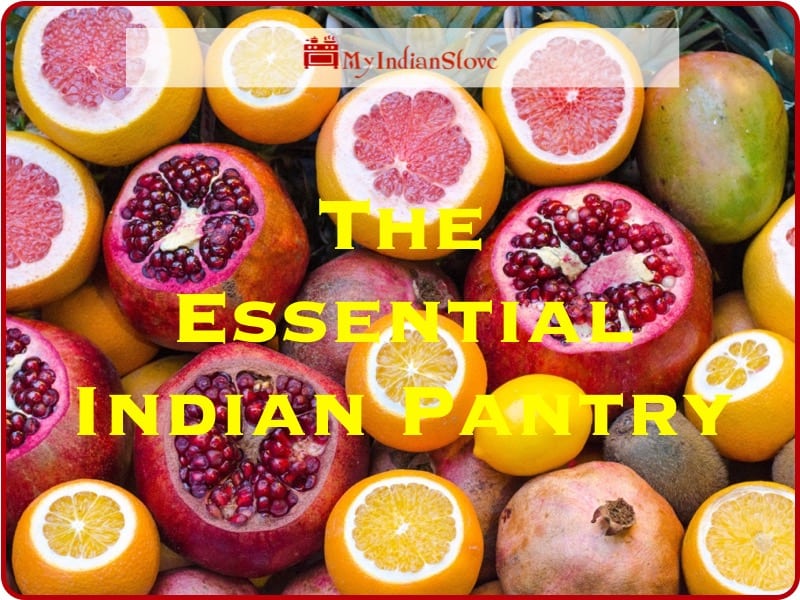
Jump to:
Essential Indian Spices to Get You Started
- Cardamon, green (choti/hari small elaichi), whole
- Cinnamon (dalchini), whole and ground
- Cloves (laung), whole
- Coriander (dhania), whole
- Cumin (jeera), whole
- Garam masala, a spice mix which varies from region to region, and dish to dish.
- Mustard seeds (sarson), yellow, black or brown (the darker the seeds, the more intensely flavored)
- Red chilies or flakes (lal mirch), Kashmiri chiles are not particularly hot and used mainly to add color to a dish. Ground red chili can be found at an Indian grocery, or online in medium or hot versions. Cayenne is a good substitute on the hotter end. If you are heat shy, do what I do when cooking a recipe for the first time and halve the number of chilies called for. Then add more heat at the end of cooking if the dish needs it.
- Sweet paprika (desi/mithi mirch), not smoked, used for color
- Turmeric (haldi)
Where to Buy Indian Groceries
Since I am cooking for two and like to buy my spices in small quantities, I have found a store in my town that carries good quality spices in bulk. So I can buy as much as I will use in 6 months.
If you don't have an Indian store nearby, the good news is the grocery stores are carrying more and more basics for the Indian kitchen. Paneer, a good selection of dals, and basic herbs and spices are more commonly carried.
Buying non-perishables online is also a good option. I most frequently buy harder-to-find ingredients from Amazon, Kalustyans, or Penzeys. Other good sources for Indian food are ishopindian.com, Patel Brothers, and World Spice Merchants.
Storing Spices
Spices are best stored in tightly lidded jars, in a cool, dark place. Buy in quantities that you will use in 6 months for ground spices, and 2 years for whole ones. In the ideal world, time and energy permitting, you will toast a small quantity of whole spices and grind as needed. There is a big difference in the end result and may find that the additional effort is worth it. However, I will completely understand, if you are not always living in an ideal world!
See Advanced Indian Pantry for more spices.
Aromatics, Fresh and Dried Herbs
- Bay leaves, dried (tej patta) Indian bay leaves add cinnamon and clove notes to a dish. From the Cassia tree, these bay leaves have a slightly different flavor profile than the more commonly found European laurel bay. If you want to more closely approximate the Indian bay leaf, you could add a small piece of cinnamon bark, but using the bay leaf you have is perfectly acceptable.
- Chilies, dried and fresh (mirch) red (dried) and green (fresh) are used for color, heat, and flavor.
- Curry leaves, fresh (sweet neem leaves, karee patte) curry leaves can be purchased dried, but I encourage you to try to find this aromatic leaf, either locally or found online. They are perishable, but can certainly survive a couple of days en route to your kitchen. If I have more than I can use in a week, I put in freezer bags and take out as needed.
- Garlic (lahsun)
- Ginger, fresh (adrak)
- Fenugreek leaves, dried (kasoori methi)
- Mint leaves, fresh (pudina)
- Lemons (neembu)
Refrigerator Staples
- Coriander/cilantro, fresh (taaza dhania) if you don’t like cilantro, use flat-leaf parsley
- Ghee clarified butter, see my Ghee, Glorious Ghee recipe
- Ginger garlic paste, this equal measure of ginger and garlic blend is another one of those indispensable ingredients that are used over and over. It is available for purchase but is better homemade. If buying this paste, here are two brands recommended: Laxmi and Swad, both pretty easy to find, if not, buy online. You might consider ginger garlic paste optional, which is fine if you don’t mind making your own for each recipe
- Plain yogurt (dahi/dahee) is a foundational ingredient in the Indian kitchen. Used for both the sweet and the savory, in marinating meat, and as a drink. Priya Krishna wrote a great article on cooking with yogurt in the online magazine Taste.
- Tamarind concentrate (imalee)I use the Tamicon brand. Refrigerate after opening
Pantry, as Needed
- Avocado oil (makhanphal tael) or other neutral vegetable oil of your choice
- Cashews (kaju)
- Coconut oil, virgin (narial ka tael)
- Chickpeas (kala channa), canned
- Coconut milk (nariyal ka doodh)
- Jaggery (gur) is a light brown sugar, with a touch of caramel and smoke. Less sweet than brown sugar, so if replacing with brown sugar, use slightly less
- Rose water (gulab jal)
- Tomatoes (tamatar), canned
- Vinegar, white (sirka)
Grains, Flours, Dried Deans, & Lentils (dals, daals)
I don’t recommend that you run out and get all of these lentils. They are listed so that you have different names of commonly used pulses (lentils, dried beans, and peas). It is helpful to know that when a pulse is split it is called dal. And if you have rice, white flour, and split gram dal (urad), that will get you started:
- Basmati rice, Tilda and Royal brands
- Gram flour (besan), chickpea flour (gluten-free)
- Maida flour, white flour (all-purpose works)
- Chapatti/atta flour, similar to whole wheat flour, but ground more finely
Start with split pigeon peas as an all-purpose lentil, and then add the others as needed in your cooking.
- Split pigeon peas/yellow split peas (toor dal, arhar dal/matar dal)
See the Advanced Indian Pantry for other pulses to gather.
For more detailed information about cooking Indian rice, read Nik Sharma’s article in the San Francisco Chronicle. By the way, he has a great blog called A Brown Table and is the author of the new cookbook Season: Big Flavors, Beautiful Food.
For detailed descriptions of lentils, beans and pulses see Indiaphiles.com. And for a list of more Indian pantry ingredients see my Advanced Indian Pantry post.
Happy Cooking!
~Alonna

